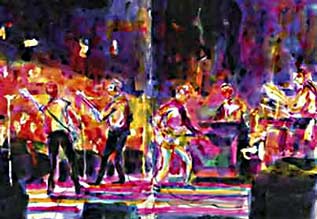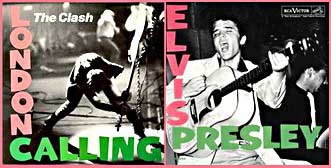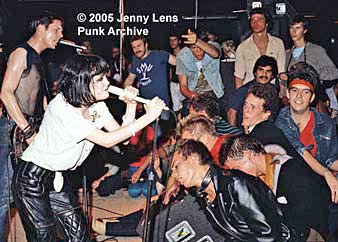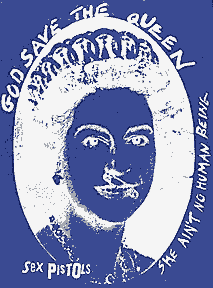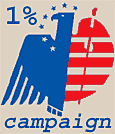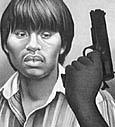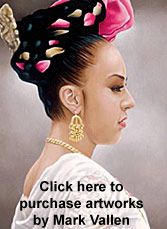[ UPDATE - Gee Vaucher's exhibit, Introspective, will be on display in Los Angeles from April 12 through May 3, 2008 at Track 16 Gallery. ]
Mostly known for the remarkable graphics she produced for the late 70’s British anarchist punk band Crass, Gee Vaucher continues to create extraordinarily insightful imagery that strips away society’s veneer to reveal hidden truths. Introspective, her current exhibit at the Jack Hanley Gallery in San Francisco, gives further evidence of her importance as a socially conscious artist for our time. Vaucher’s exhibit opened on Dec. 14, 2007, and surprisingly… San Francisco’s local NBC affiliate dropped-in to cover the opening. Click here to view NBC’s slideshow of the event, which gives a pretty good visual summation of the evening as well as showcasing the quality of Vaucher’s art.
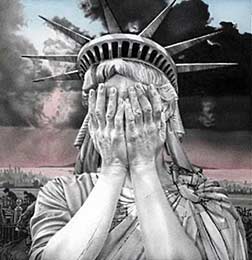
[ Liberty - Gee Vaucher. Gouache and pencil on paper. 2006? ]
Vaucher’s proficiency at drawing serves as the rock solid foundation for her art, and she calls upon traditional skills to create her complex paintings. Even as a young art student, it was clear that Vaucher had a natural talent for figurative realism, but possessing and utilizing time-honored methods does not necessarily lead to conventional artworks - and one would be mistaken to call Vaucher’s works "conservative." Another misjudgment would be to accept the commonly held view of punk aesthetics as minimalist, crude, mindless, and intentionally designed to repulse. Vaucher’s early works for Crass were intellectually sophisticated, technically well crafted, and dare I say - beautiful. Full of narrative and profound meaning, they wielded a social critique as pertinent today as when they first appeared decades ago. If at times Vaucher’s works seem a bit obscure in a surrealist manner, they are always clear in communicating a love of humanity and utter contempt for despotism.
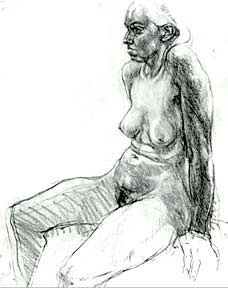
[ Life drawing - Gee Vaucher. Pencil on paper. 1954. Sketch of a live model done in art college. ]
Vaucher visited Los Angeles in 2000 for a limited speaking tour, where I was fortunate enough to exchange a few brief words with her on the subject of art and politics. Many people have assumed that her works were, and are, pure assemblages of photographic materials. As she explained to me, much of her work isn’t photomontage or collage at all - but hand drawn imagery created in pencil and water based gouache paint.
The painting Who Do They Think They’re Fooling? - You?, now on view at the Jack Hanley Gallery, is a perfect example of Vaucher’s didactic method and hyperrealist technique. Created in 1980 as cover art for the 7" Crass single, Bloody Revolutions, Vaucher based her artwork on a famous photo of the Sex Pistols, but the members of the mock band presented in her painting consisted of the Queen of England, Pope John Paul II, the Statue of Liberty, and Margaret Thatcher. If the Pistols were a rock 'n roll swindle, Vaucher was telling us, then the icons in her artwork represented the ultimate ruling class con job.
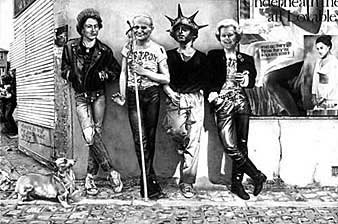
[ Who Do They Think They’re Fooling? - You? Gee Vaucher. 1980. Gouache and pencil on paper. Cover art for the 7" Crass single, Bloody Revolutions.]
Yo! What Happened to Peace? is a traveling antiwar poster exhibit in which several of my artworks are included, so I’m thrilled to learn that Yo! organizer and curator, John Carr, has arranged a collaboration with Gee Vaucher and the Jack Hanley Gallery. On Jan. 17, 18 and 19, artists from the Yo! project will work in partnership with Gee Vaucher and Penny Rimbaud (also from Crass), to present a Yo! print exhibit and live poster screen printing event at the gallery. Artists involved in the Yo! show will bring their own silkscreens to the gallery, making posters to be given away to guests at the gallery. Some of the artists scheduled to participate in the screen printing event include Winston Smith, Art Hazelwood, Doug Minkler, Eric Drooker, Mear One, Favianna Rodriguez, and a host of others.
Gee Vaucher: Introspective, at the Jack Hanley Gallery in San Francisco, Dec. 14, 2007 through January 19, 2008. The Gallery is located at: 395 Valencia Street, San Francisco, CA 94103.
Labels: Art of Punk, Feminist art
